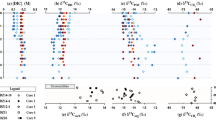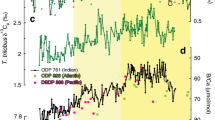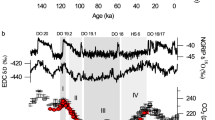Abstract
Arising from: D. B. Kemp, A. L. Coe, A. S. Cohen & L. Schwark Nature 437, 396–399 (2005); Kemp et al. reply
Dramatic global warming, triggered by release of methane from clathrates, has been postulated to have occurred during the early Toarcian age in the Early Jurassic period1. Kemp et al.2 claim that this methane was released at three points, as recorded by three sharp excursions of δ13Corg of up to 3‰ magnitude. But they discount another explanation for the excursions: namely that some, perhaps all, of the rapid excursions could be a local signature of a euxinic basin caused by recycling of isotopically light carbon from the lower water column. This idea has been proposed previously (see ref. 3, for example) and is supported by the lack evidence for negative δ13C excursions in coeval belemnite rostra4. Kemp et al. dismiss this alternative, claiming that each abrupt shift would have required the recycling of about double the amount of organic carbon that is currently present in the modern ocean; however, their measurements are not from an ocean but from a restricted, epicontinental seaway and so would not require whole-ocean mixing to achieve the excursions.
Similar content being viewed by others
Main
We also question aspects of the timing, magnitude and inferred consequences of the gas-hydrate release events. Kemp et al.2 erect a cyclostratigraphic scheme on which they found their claim that the three carbon isotope spikes all occurred within a 60,000-year period. But they do not explain how a 3‰ recovery could have occurred between their second and third excursions. This interval is only 25% of the residence time of carbon in the oceans (180,000 yr; ref. 5) and is thus too short to represent a relaxation process. Their data show further very rapid declines in δ13Corg values (for example, at 1.6 m and 2.9 m in their section) and these were not given equal status as gas-hydrate-release events. Furthermore, with three, and possibly five, closely spaced release events, there would not have been sufficient time to replenish the clathrate reservoirs between events.
Kemp et al.2 note that one consequence of the release of huge amounts of methane (at least 5,000 gigatonnes of carbon by their calculations) was the development of a severe greenhouse climate and, as a direct (but unexplained) result, the extinction of many marine species. However, this is not supported by the work they cite. The authors suggest that there could have been a sudden rise in seawater temperatures coincident with methane release6, where “sudden” indicates a period of 0.6 to 0.7 million years (ref. 6). Note also that the temperature rise began in the Dactylioceras tenuicostatum subzone6, whereas the lowest δ13Corg excursion of Kemp et al.2 is not developed until late in the succeeding Dactylioceras semicelatum subzone. Furthermore, the younger two release events coincide with a proposed phase of marked cooling, according to stomatal index data7.
The claim by Kemp et al. that the first two methane-release events led to a 67% and 50% loss in species was derived from the work of Harries and Little8; however, the resolution of that study is too low to equate the extinction losses to the level of the excursions. The original data set9 and our later findings10 show that extinction in these Yorkshire coast sections occurs in Bed 31, where 12 of 14 benthic species go extinct. This crisis was 60,000 years before the first methane-release event, according to the timescale of Kemp et al. Other extinctions in the European region were even earlier, with many taxa disappearing at the Pliensbachian–Toarcian stage boundary11. There is therefore no evidence to relate the Toarcian mass extinction to the effects of gas-hydrate dissociation events, although they do relate to the development of bottom-water anoxia.
References
Hesselbo, S. P. et al. Nature 406, 392–395 (2000).
Kemp, D. B., Coe, A. L., Cohen, A. S. & Schwark, L. Nature 437, 396–399 (2005).
Sælen, G., Tyson, R. V., Talbot, M. R. & Telnæs, N. Geology 26, 747–750 (1998).
van de Schootbrugge, B. et al. Paleoceanography 20, PA3008, doi:10.1029/2004PA001102 (2005).
Katz, M. E. et al. Mar. Geol. 217, 323–338 (2005).
Bailey, T. R., Rosenthal, Y., McArthur, J. M., van de Schootbrugge, B. & Thirlwall, M. F. Earth Planet. Sci. Lett. 212, 307–320 (2003).
McElwain, J. C., Wade-Murphy, J. & Hesselbo, S. P. Nature 435, 479–482 (2005).
Harries, P. J. & Little, C. T. S. Palaeogeog. Palaeoclim. Palaeoecol. 154, 39–66 (1999).
Little, C. T. S. Thesis, Univ. Bristol (1994).
Wignall, P. B., Newton, R. J. & Little, C. T. S. Am. J. Sci. 305, 1014–1032 (2005).
Little, C. T. S. & Benton, M. J. Geology 23, 495–498 (1995).
Author information
Authors and Affiliations
Corresponding author
Rights and permissions
About this article
Cite this article
Wignall, P., McArthur, J., Little, C. et al. Methane release in the Early Jurassic period. Nature 441, E5 (2006). https://doi.org/10.1038/nature04905
Published:
Issue Date:
DOI: https://doi.org/10.1038/nature04905
This article is cited by
-
Methane release in the Early Jurassic period (Reply)
Nature (2006)
Comments
By submitting a comment you agree to abide by our Terms and Community Guidelines. If you find something abusive or that does not comply with our terms or guidelines please flag it as inappropriate.



